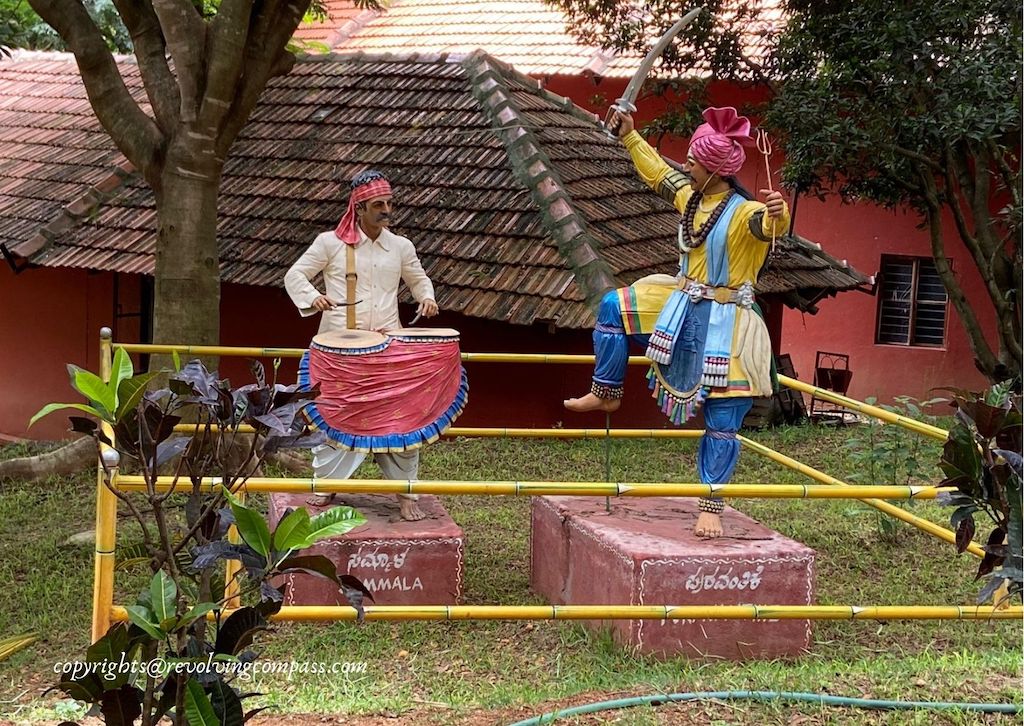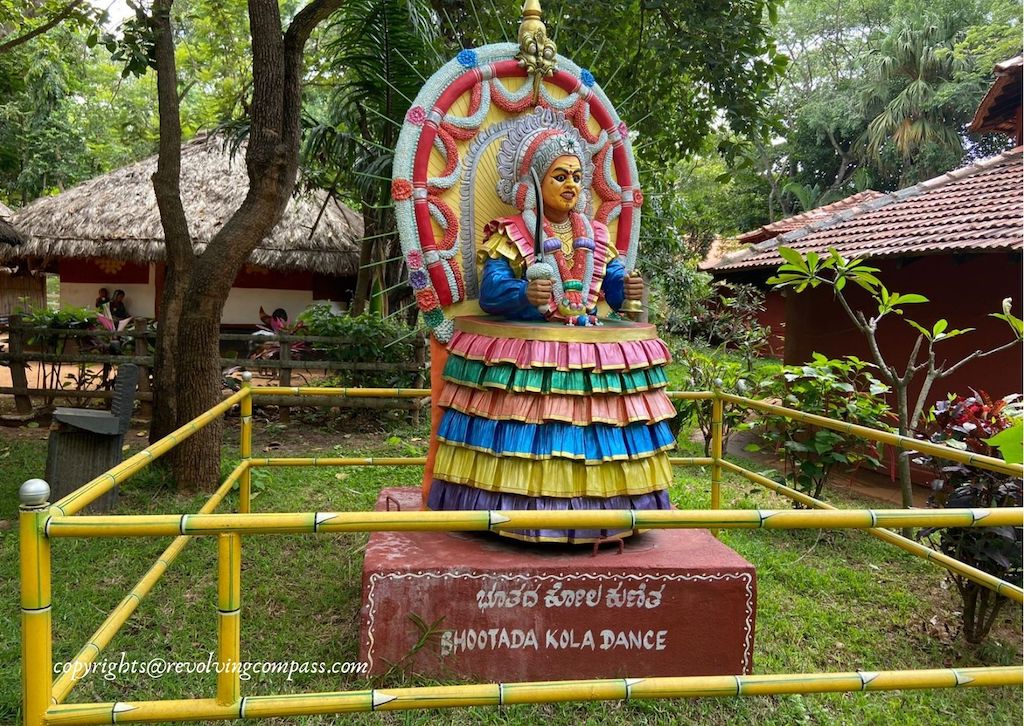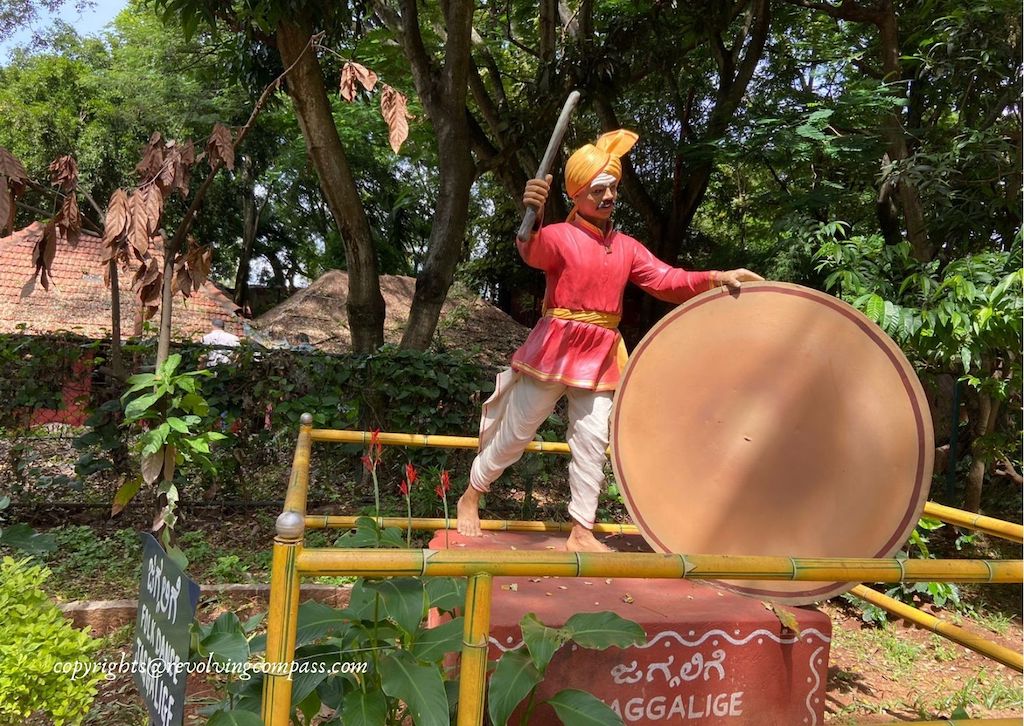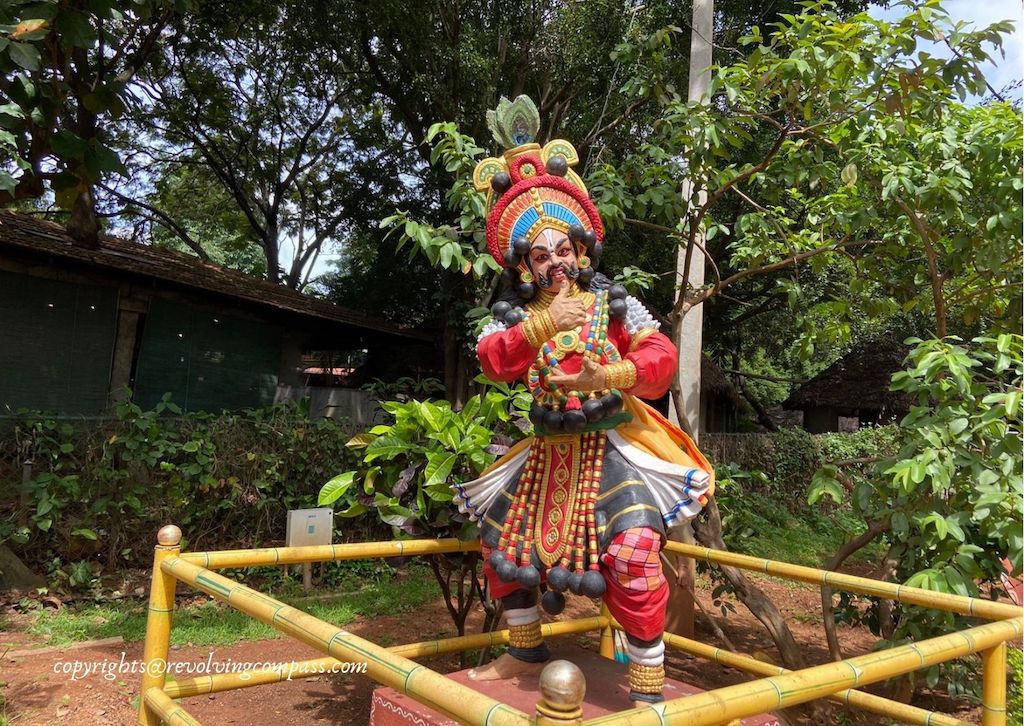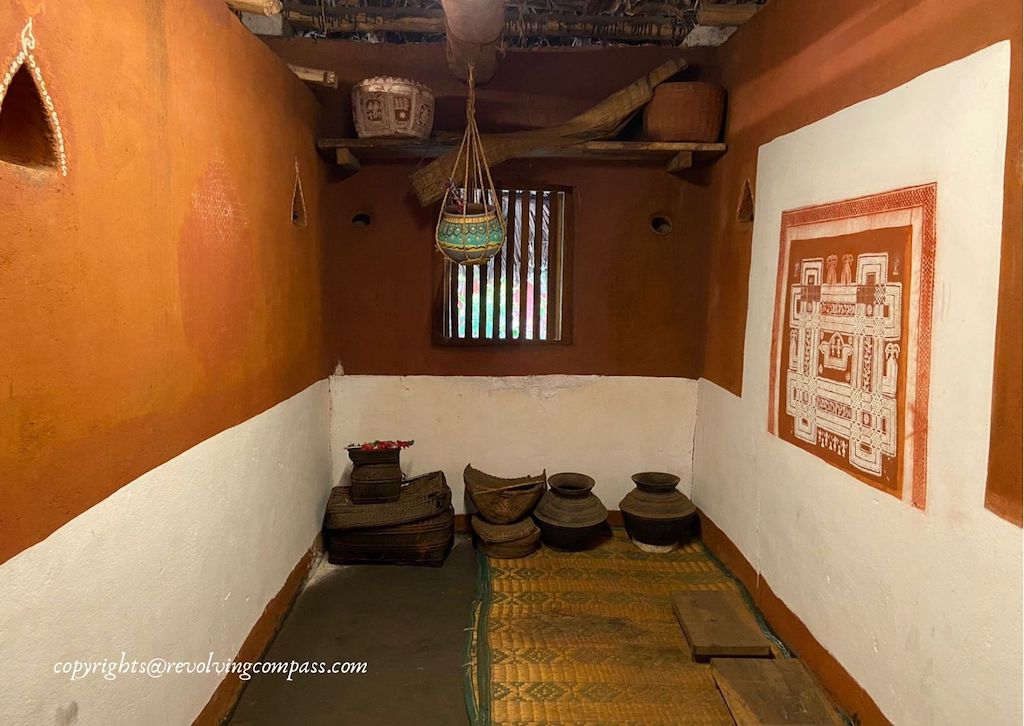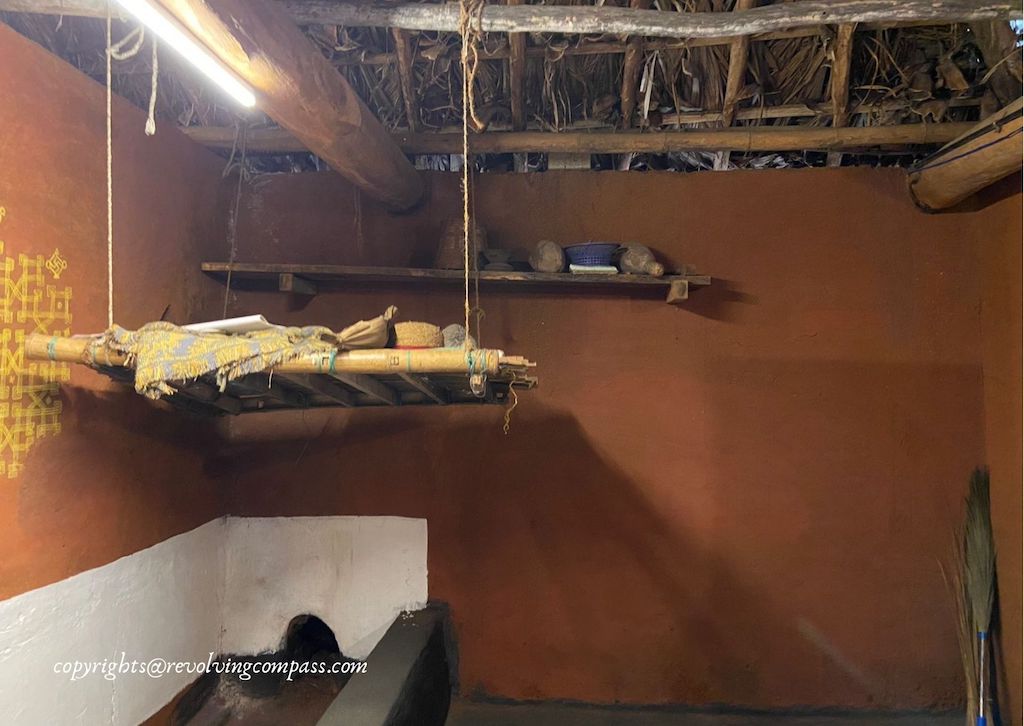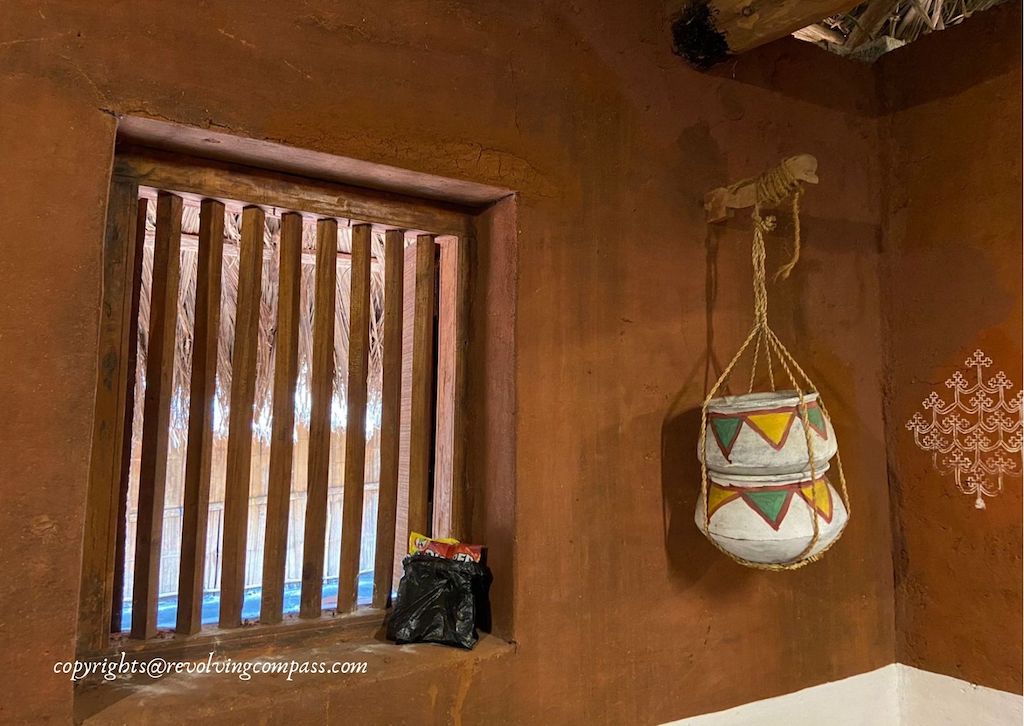Countless times have we crossed the Ramanagara district and Channapatna town on our multiple trips to Ooty, our trip exploring the town of Mysore and the Mysore Zoo, our trip to Coorg, when we went to Kabini and to Wayanad. But never did we get a chance to stop at Janapada Loka Ramanagara. It is a beautiful folk art museum of Karnataka located right on the highway. Just besides Kamat Lokaruchi, where we even had breakfast on our previous trips. Situated just around 53 km from the town of Bangalore on the Bangalore Mysore highway, the Janapada Loka Ramnagara Museum makes for not just a perfect day trip from Bangalore. But also a perfect educational trip for kids and adults alike. Commonly, it is also known as the “Folk Culture World”. In fact, the word “Janapada loka” means “folk cosmos” !!
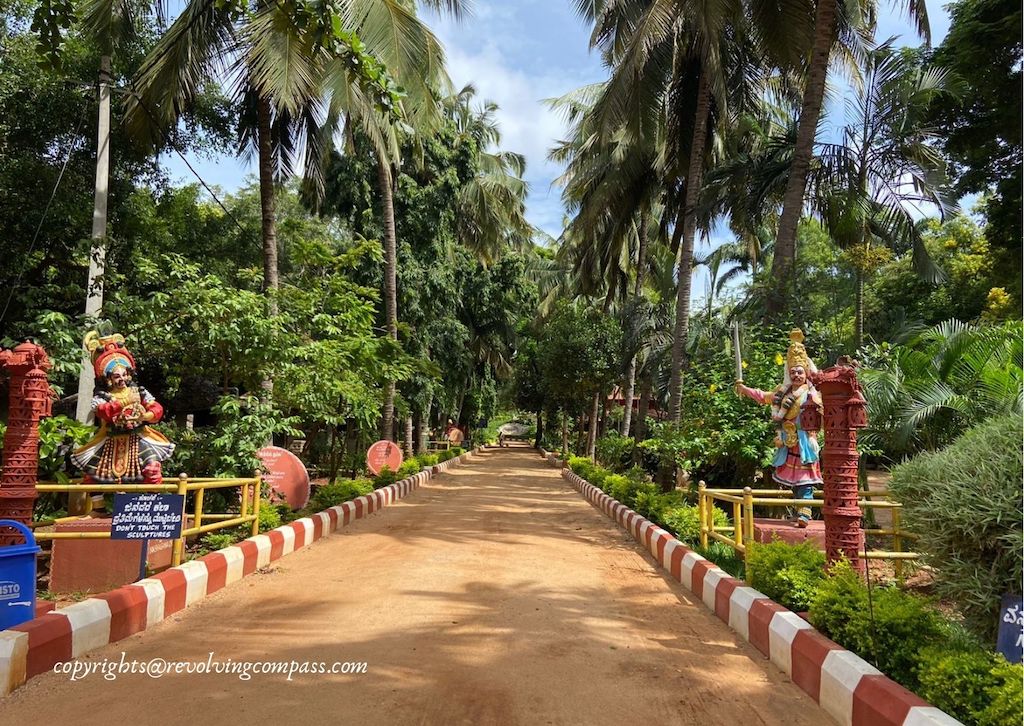
Considered one of the prominent cultural hub of India, the Janapada Loka Ramanagara museum was constructed by Sri H. L. Nage Gowda, a prominent civil servant of Karnataka. Mr. Gowda was an enthusiast and quiet attached to the rural and traditional culture of the state of Karnataka. It pained him to see that many of the traditional ways of living and working were slowly becoming extinct. As the modern amenities were slowly adapted in all spheres of life. He created this museum to depict how the rural life looked like 3-4 generations back to a century back. And for creating this museum, he and his friends collected artefacts for over three decades. Beautiful life-like models are used all through the various parts of the museum to depict old rural life of Karnataka. Moreover, the museum is a complete open air museum in the middle of lush greenery.
Table of Contents
Visiting the Janapada Loka Ramanagara Museum
We visited Janapada Loka Ramanagara Museum (sometimes also referred to as Janapada Loka Bangalore) on a Saturday morning. Although we initially planned to have the buffet breakfast served at the adjacent restaurant. But, by the time we reached the Bangalore Mysore highway, it was already 8:30 am. So, instead, we stopped at an Adyar Anand Bhavan (A2B) for breakfast. After having delicious masala dosa for breakfast and filter coffee, we proceeded further.
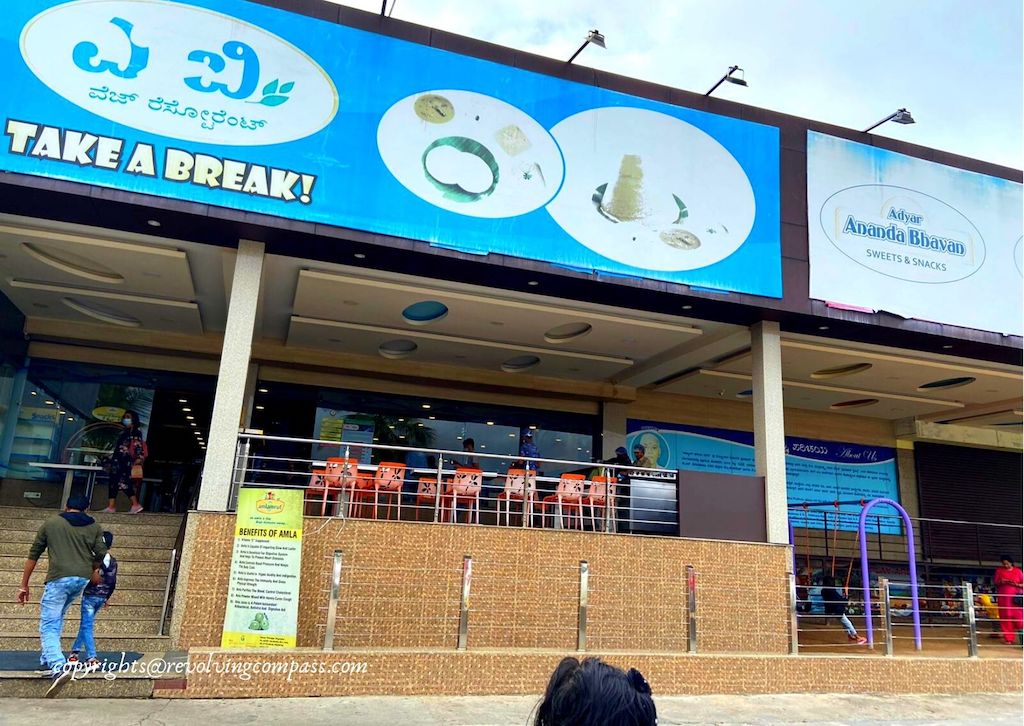
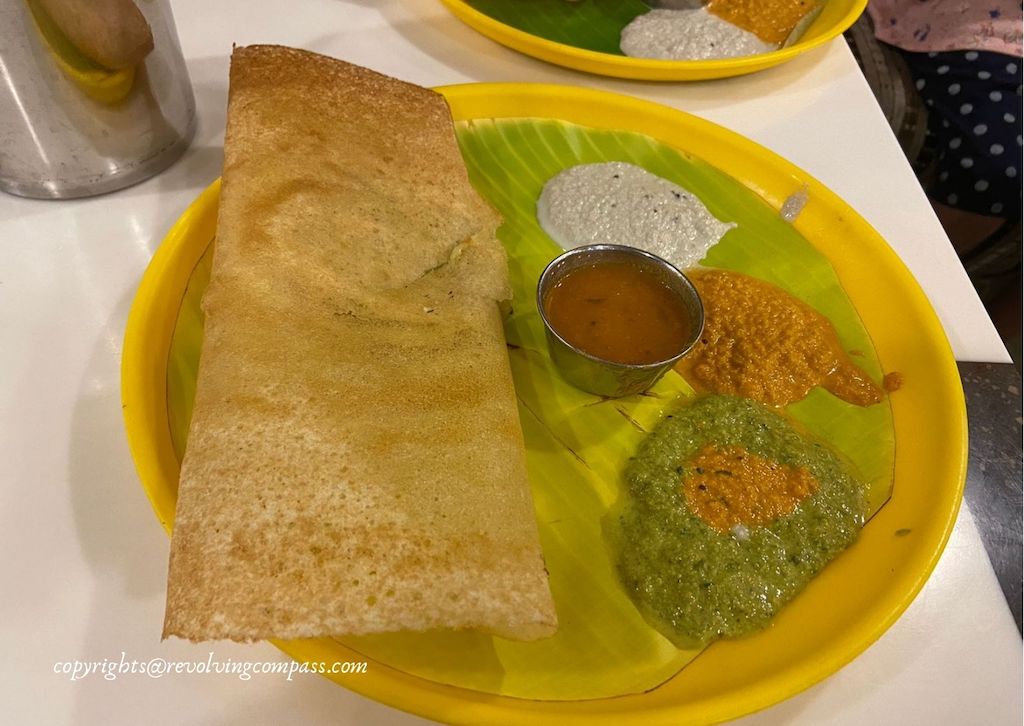
Janapada Loka Ramanagara Museum is open from 9:30am to 5:00pm from Monday to Sunday except for Tuesdays. It is also closed on National Holidays. There is no specific parking inside the campus. You can park by the side of the road, on either side of the entrance to the Museum. There is an entry fee of INR 50/- per adult and INR 25/- per kid above 5 years of age. When we reached here around 10:00am, there was no rush. So, we parked our vehicle besides the museum entrance. Took our entry tickets. And entered inside. But before we did that, couldn’t help noticing the massive artistic gate that features two pillars on either side with Nandidhwajas. The gate is very intricately done. It has brass trumpets and face of Lord Shiva and Vishnu embossed on the leaves of the gate as it’s prominent structure.
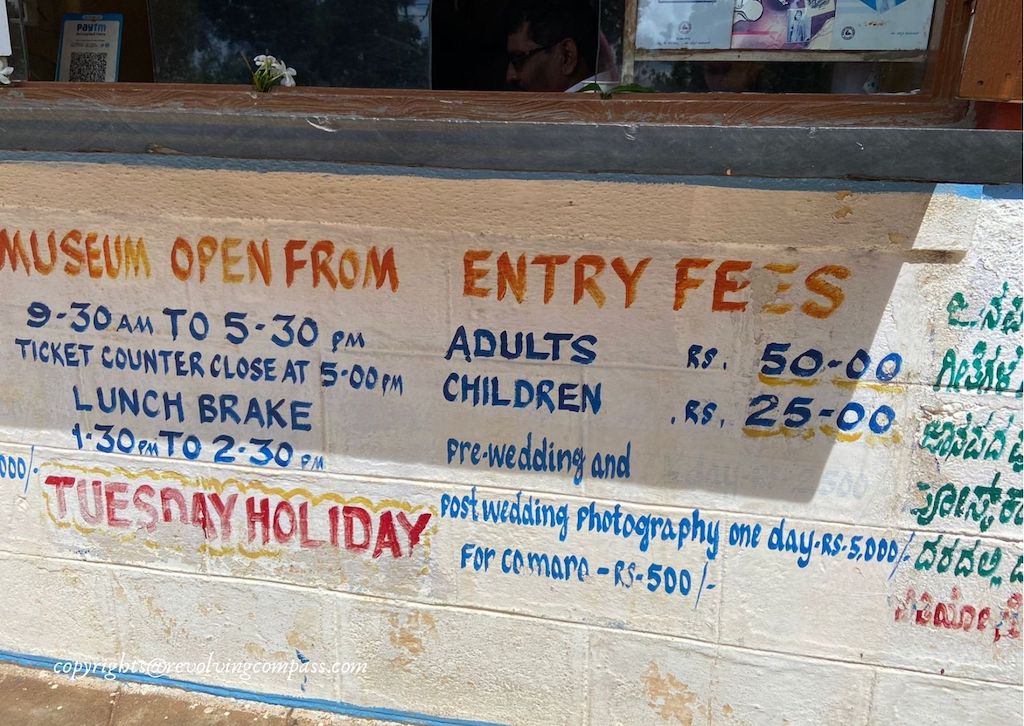
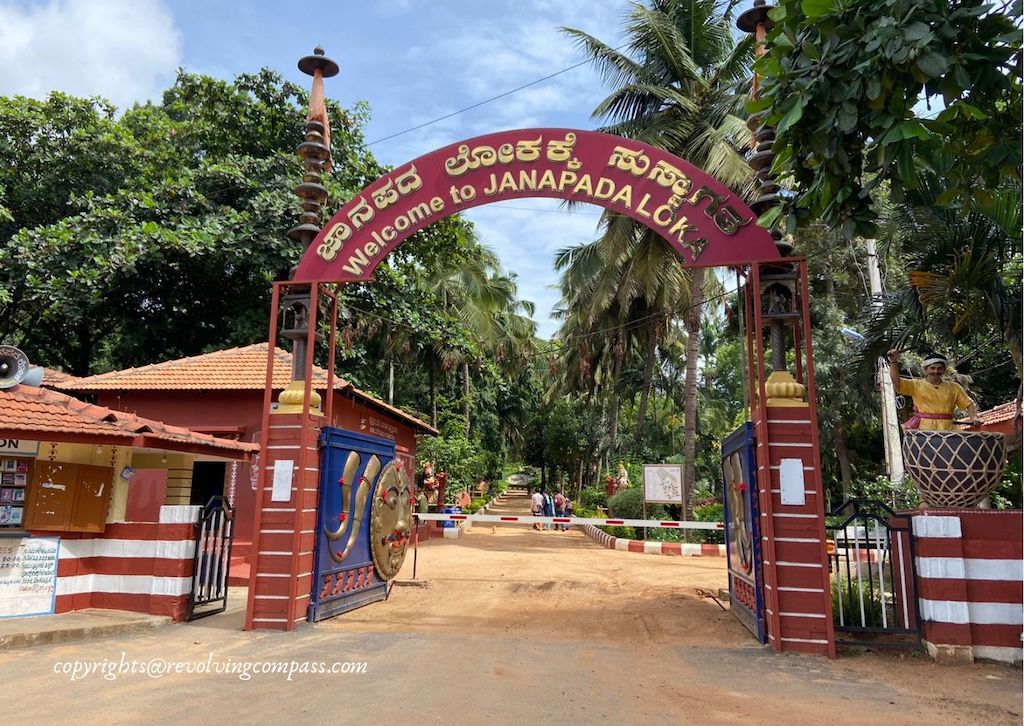
The Folk Dance of Karnataka depicted in Janapada Loka Museum
As you enter inside the Janapada Loka Museum and start walking in the green campus, the first thing you see is the “Lok Mata Mandir” which is the information centre. Next what catches attention is the various life size murals depicting the different folk dance forms of Karnataka. These vibrant murals peeking through the plantations immediately catch your eyes. Honestly, I didn’t know that there are so many forms of dance here in this state, until I visited here.
Further down, there is a beautiful open air amphitheatre. Folk art performance are done here towards the evening. So, do plan to visit towards the lake afternoon time to catch the shows. In fact, overall there are 5000 different folk artefacts depicted in this museum.
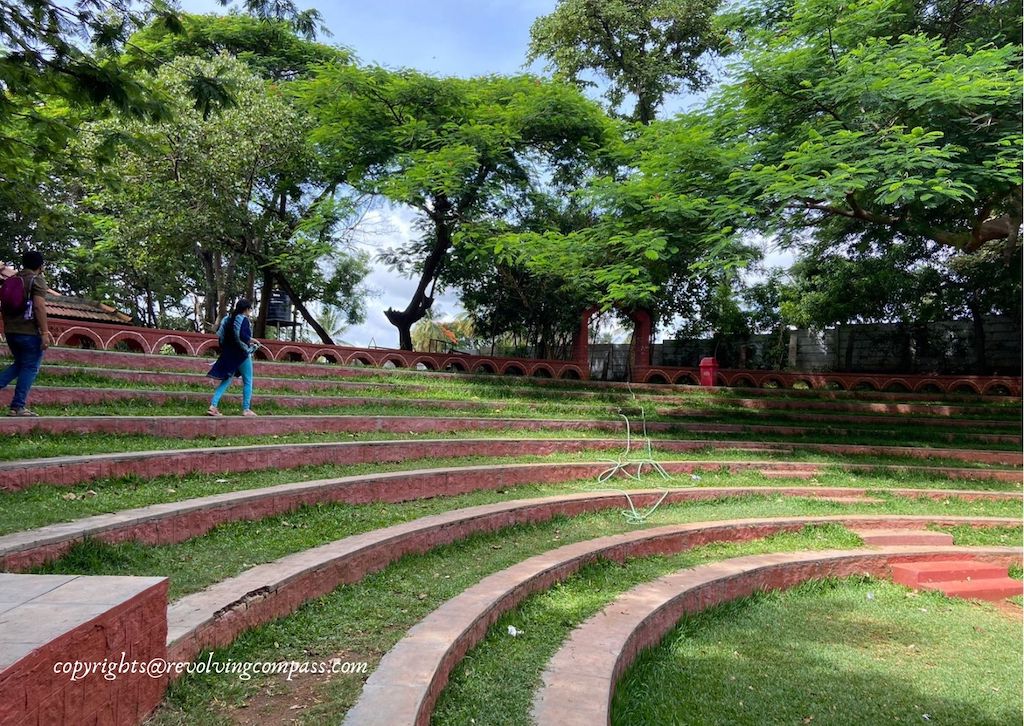
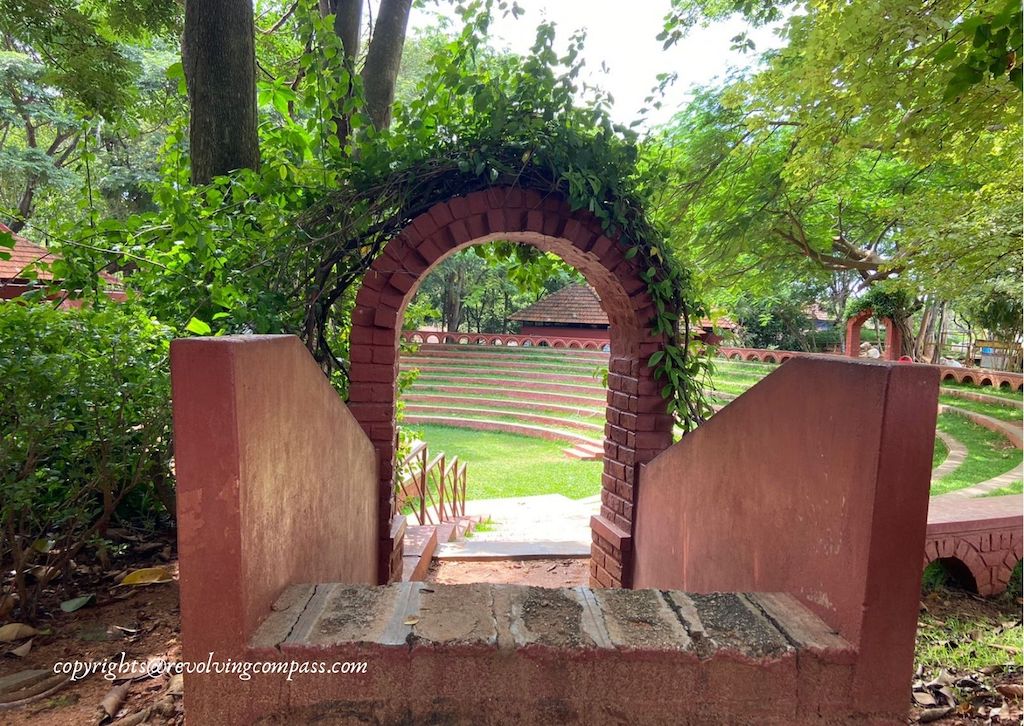
Doddamane
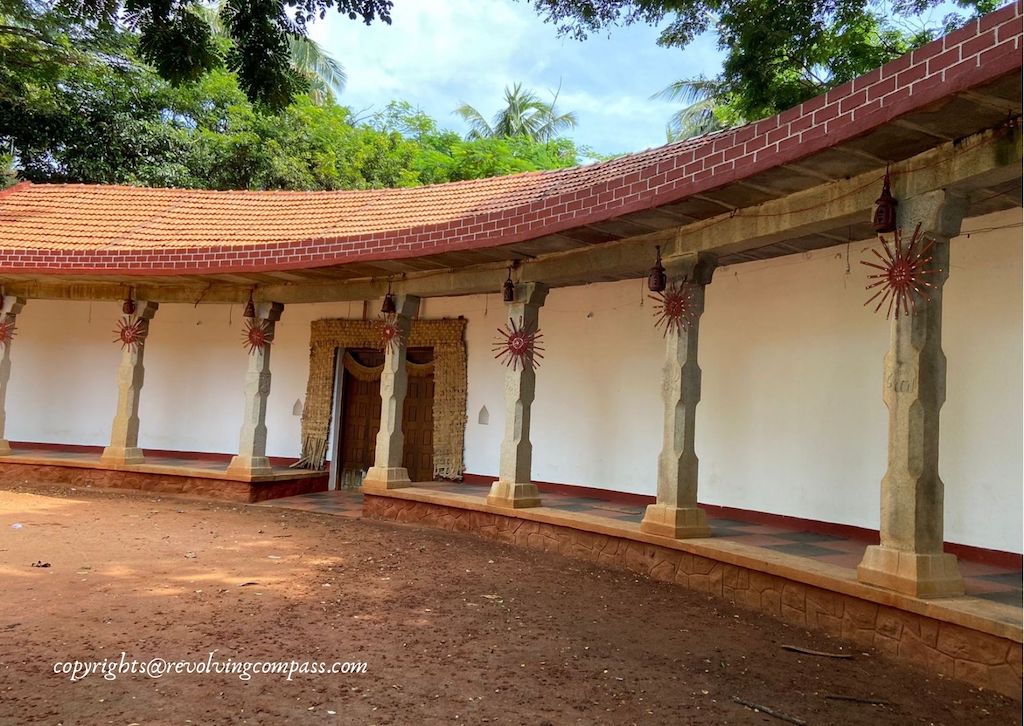
On the right side of the amphitheatre you will see Doddamane (meaning “big house”) which is a replica of a large traditional village house. It has a central courtyard with pillars around which the rest of the rooms are built. Actually, Doddamane is used as a community house of the museum complex. A lot of seminars and workshops are organised here. Actually, this also serves as a lodge for folk artistes who make handicrafts like pottery and wooden toys. Or those who are associated with training people interested in the folk art. They are provided accommodation here. Development skills in creating folk arts such as “Dollu Kunitha“, “Kolata” and “Goravara Kunitha” are also provided here to encourage and keep the art alive.
The landscaped pond in the middle of Janapada Loka Museum
As you walk further towards the left, there is a beautiful earthen shade. And besides it, there is a pond. In which you can see swans and ducks swimming. The artificial bear and crocodile installed around the pond are a testimony to how beautifully each and every corner of the Museum is constructed.
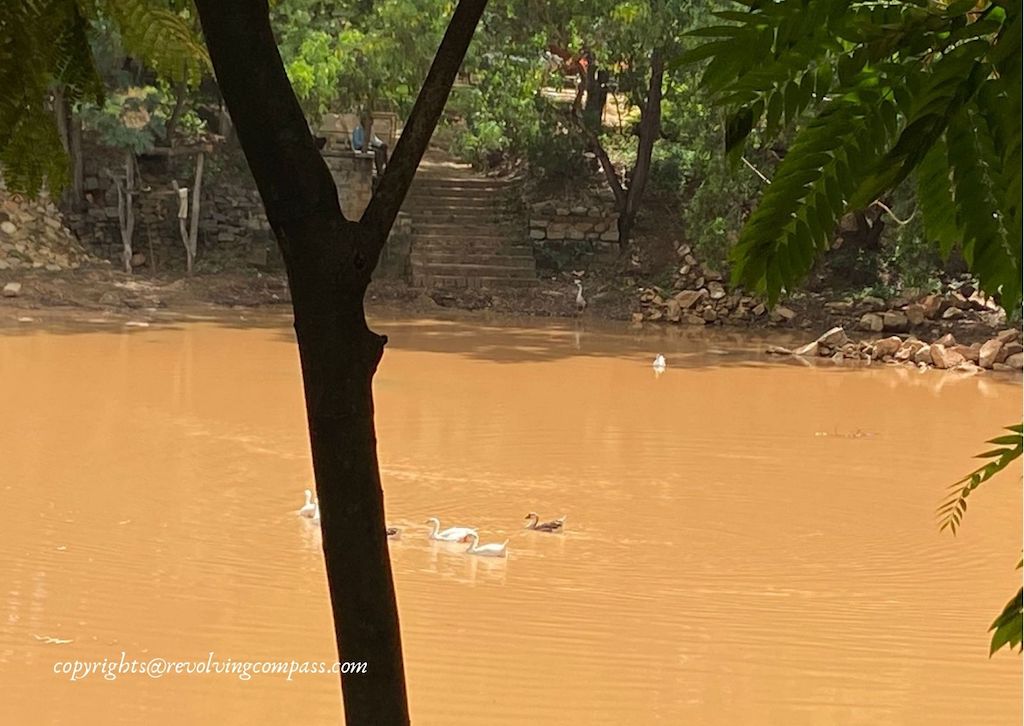
Further down, there are a few “buggies” (horse driven carts) from the previous century that are preserved here.
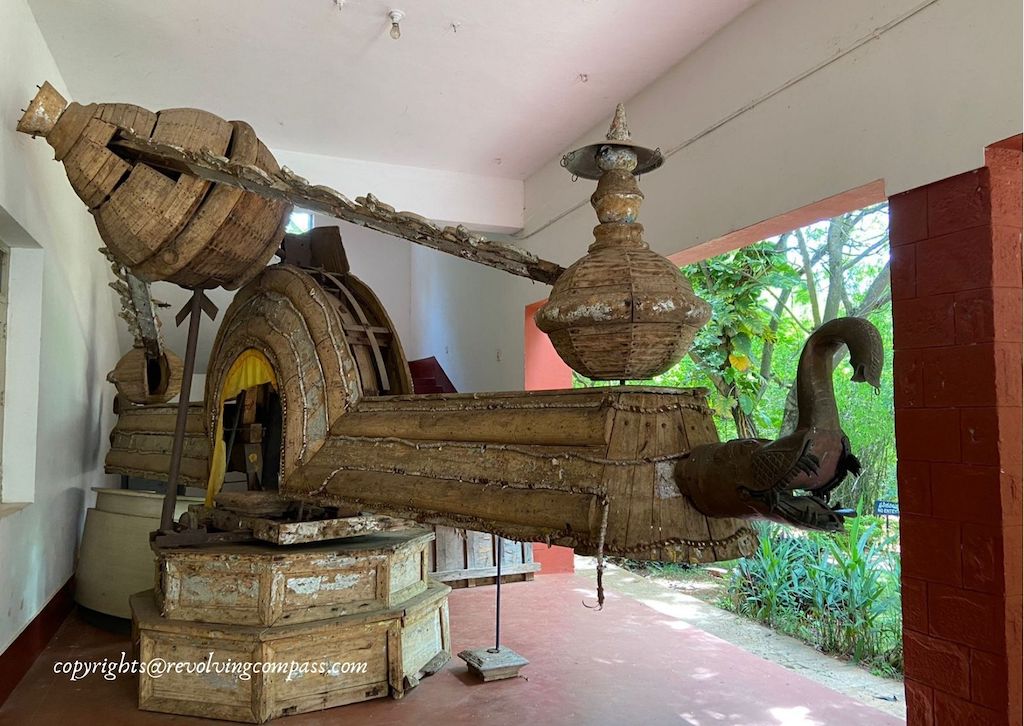
Depiction of Rural Life
After resting a bit on the benches near the pond, we started circling round the path. Wherein we came to different murals one by one that depicted the rural life of Karnataka from generations back.
The first mural depicted a man using his oxen to run a big grinder.
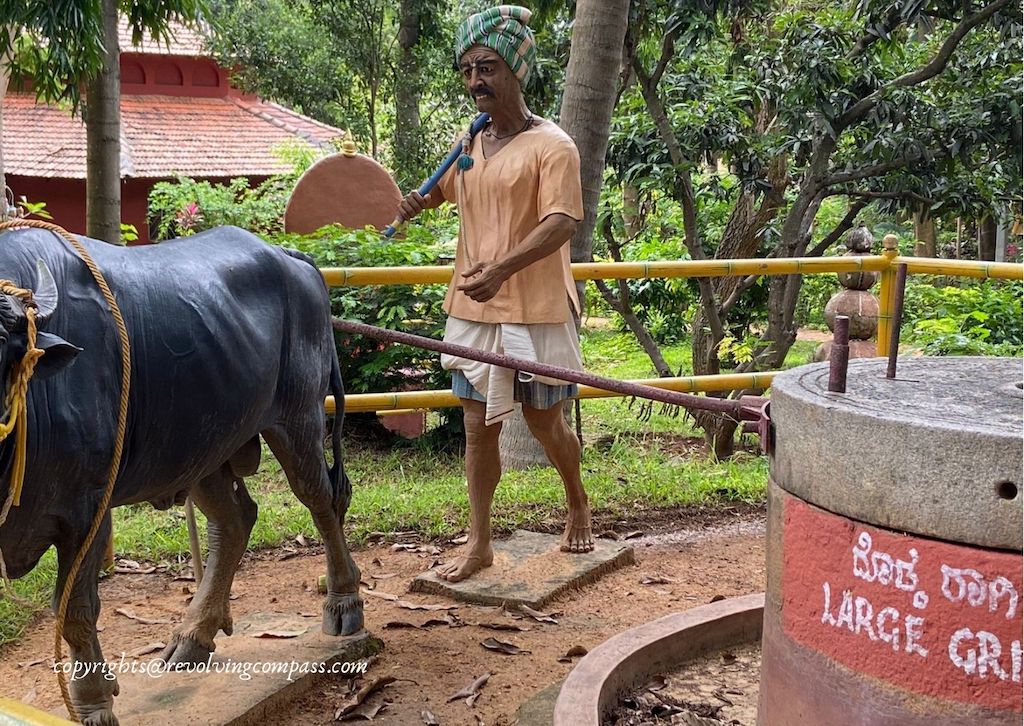
While the next one depicted a woman milking a cow in front of her hut. And another woman sitting on the porch of the hut, doing her household work.
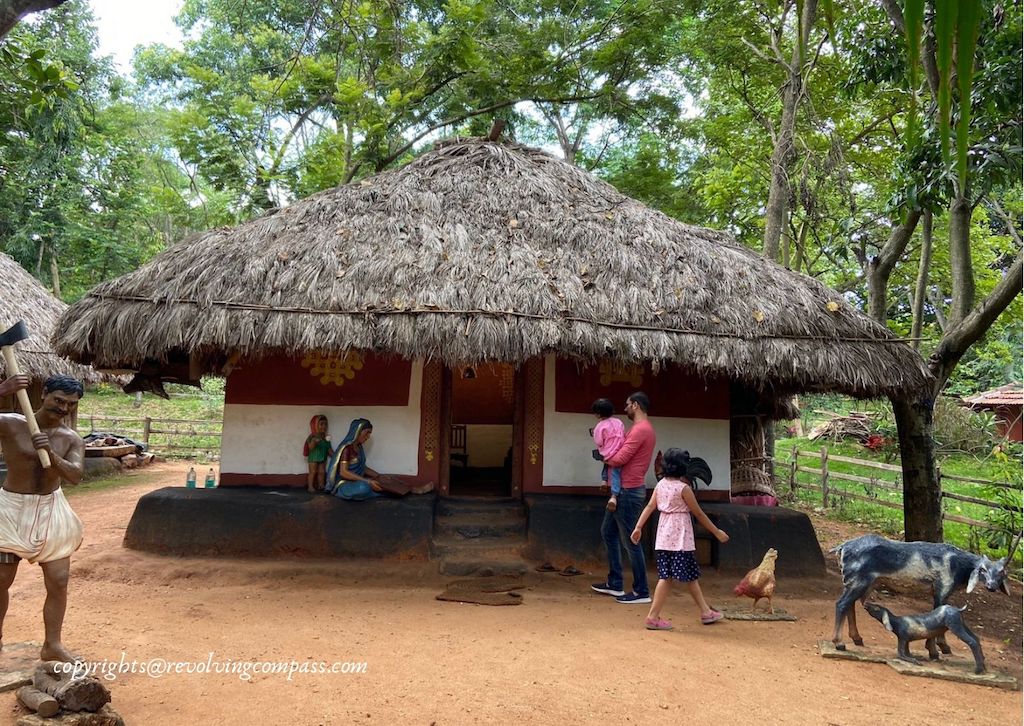
With a few hens and other common rural domestic animals roaming around the campus. This whole scene is created so realistically that it brings back memories of our own rural houses and lives there. And immediately makes you feel nostalgic. For me, it also brought back memories of the Keukenhof Tulip Gardens in Netherlands. Where a small farm was constructed in the middle of the garden. To depict the rural life there. And believe me, it was so similar to the rural life depicted here. Made me feel how the cultures around the world are so inter-connected and similar.
The mud and bamboo hut at Janapada Loka Museum
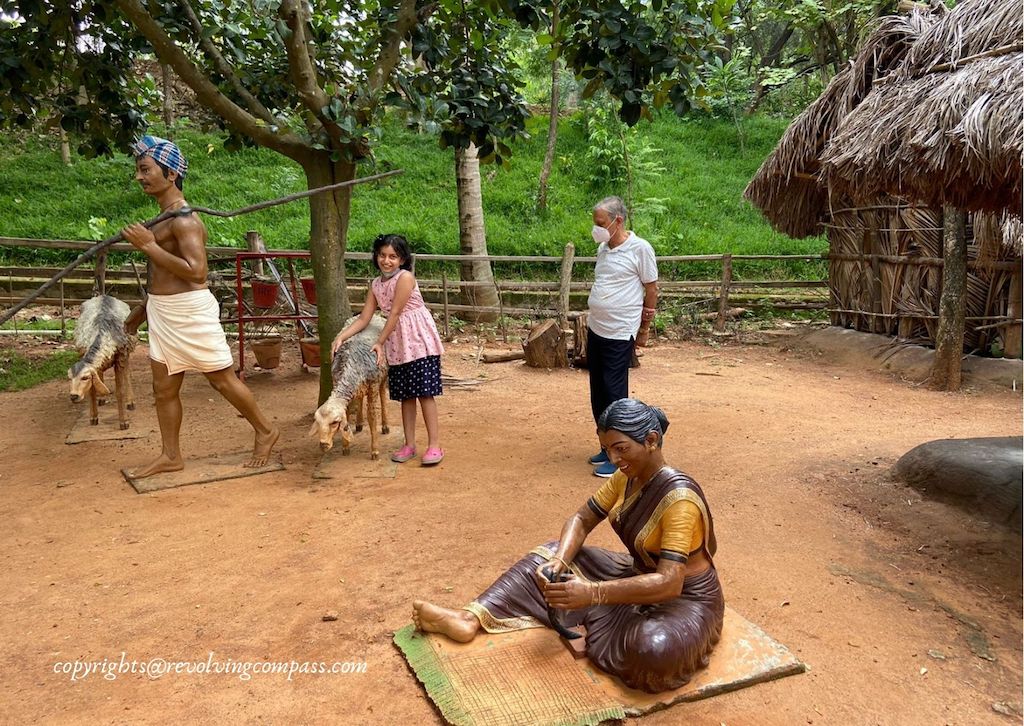
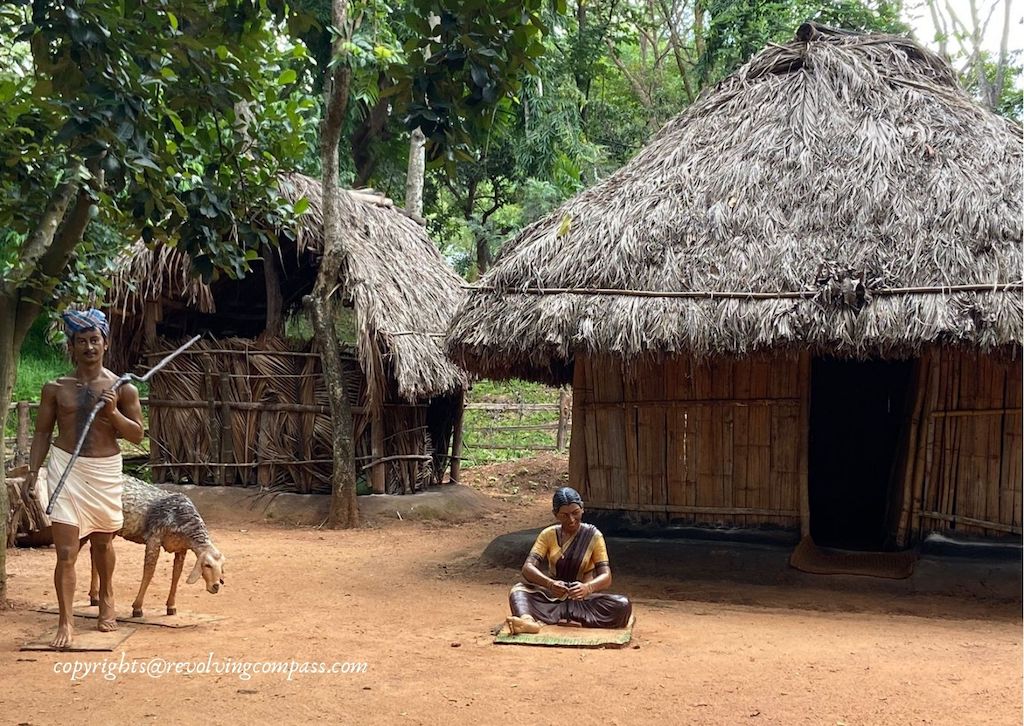
We entered inside the hut. It is a mud-house. With rooms and kitchen like how they used to be in olden days. The kitchen also had several “handis” and other earthen pots that were used for cooking in olden days. Walls with scones and racks to hold lamps so that they could be placed higher up, safely from kids. “Suplis” or cane baskets for cleaning dry grains. Even piggy bank holes high up in the mud walls were some very interesting details that amused Aashi. While she learnt about the rural life of olden days. Even some pots are hung from the wall with cotton threads, like they were done in old houses. So that the food & milk kept in these pots remained protected from cats! Even our parent, who were with us on this trip felt nostalgic, relating to all the items instantly.
Museum of ancient artefacts
As we proceeded further, we came across the first museum. Photography is prohibited inside this museum. It consists of several olden days pots, cribs and swings, spatulas, small mills and stone grinders used inside the households and several other daily use items used actually in houses years back. There are also paintings on the walls of the Museum, which are also very old. These are made with natural color. And were used for decoration during marriage and celebrations in the tribal homes.
Museum of Pictures – Chitra kuteera
There is a small museum around the corner as you exit the Museum of ancient artefacts. This one is called Chitra Kuteera. It has pictures of many prominent figures including Sri H. L. Nage Gowda – the founder of this place. The pictures and photographs also show the journey of the museum’s founder to different folk communities and how he went about collecting the artefacts for decades. Before he could build this place.
Loka Mahal
Another two storey museum at Janapada Loka Ramanagara, this one has 5000+ artefacts. The puppets here are more than 500 years old. These depict several dance forms, musical instruments used in the ancient times, ceremonial dance possessions, traditional ornaments and jewellery and puppets used for puppetry shows.
Depiction of rural industry in Janapada Loka museum –Ayagaramala
Actually there was nothing like an industry with machinery and all in the ancient India. Most of the work was done in a very eco-friendly way. Employing domestic animals and few simple tools. And that is what you will see through the depictions in the Janapada Loka Ramanagara Museum as you move further to a section called “Ayagaramala“.
There is one section depicting how oil was extracted in ancient times using oxen and few simple stone and wood tools. The oxen would run in a circle, moving the rotary and slowly oil would be extracted from the seeds as a part of this process.
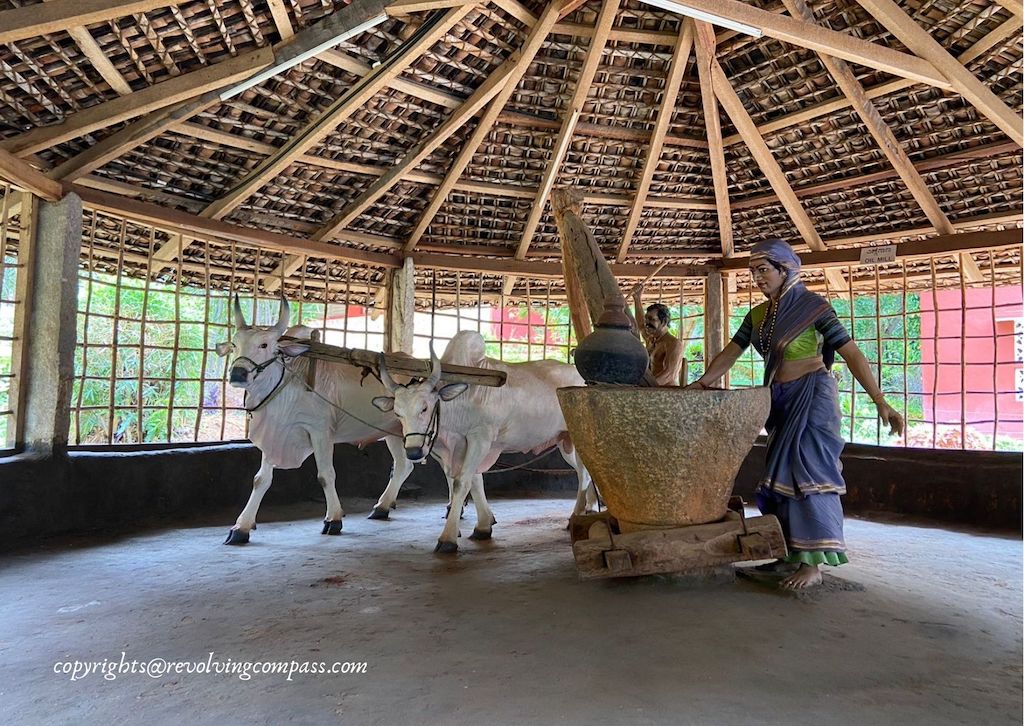
The next one depicts how iron smith worked at that time, creating iron tools and household need items. How they used to heat iron by burning coal and then keep hitting it to produce soft sheets which could then be moulded in tools and containers as required.
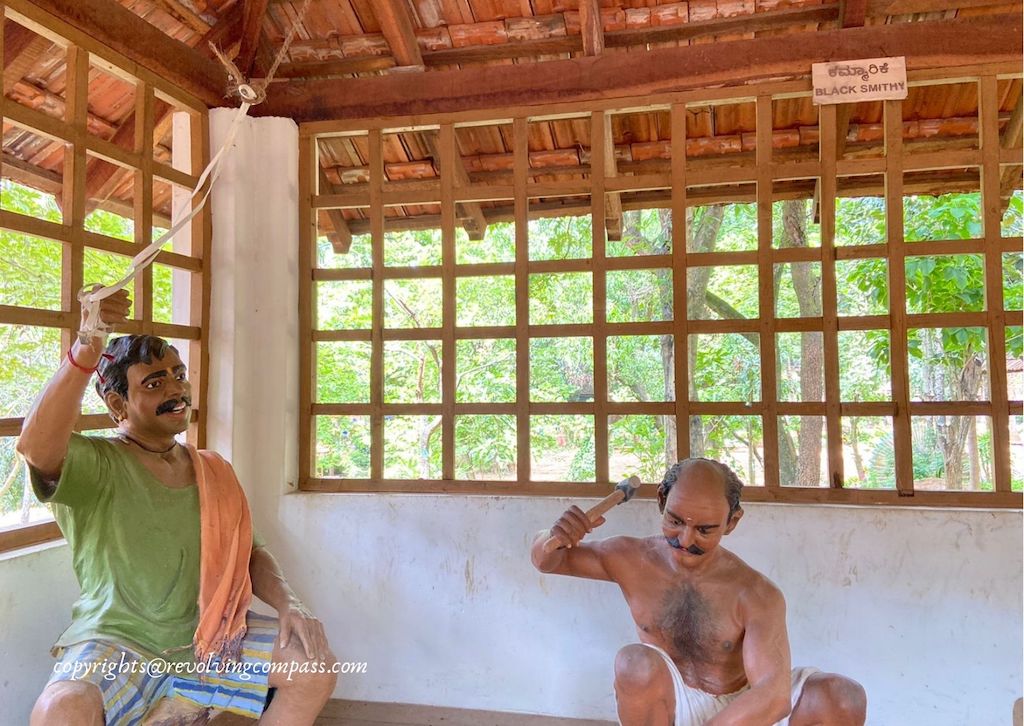
And after passing through these two we arrived at the pottery section. In the rural India, mostly clay pots were used to cook food. They consisted of 90% of the utensil in the rural kitchen. Here, we got to see a man making beautiful clay pots. And there is a small room where the created pots are kept. You can also buy the pots from here.
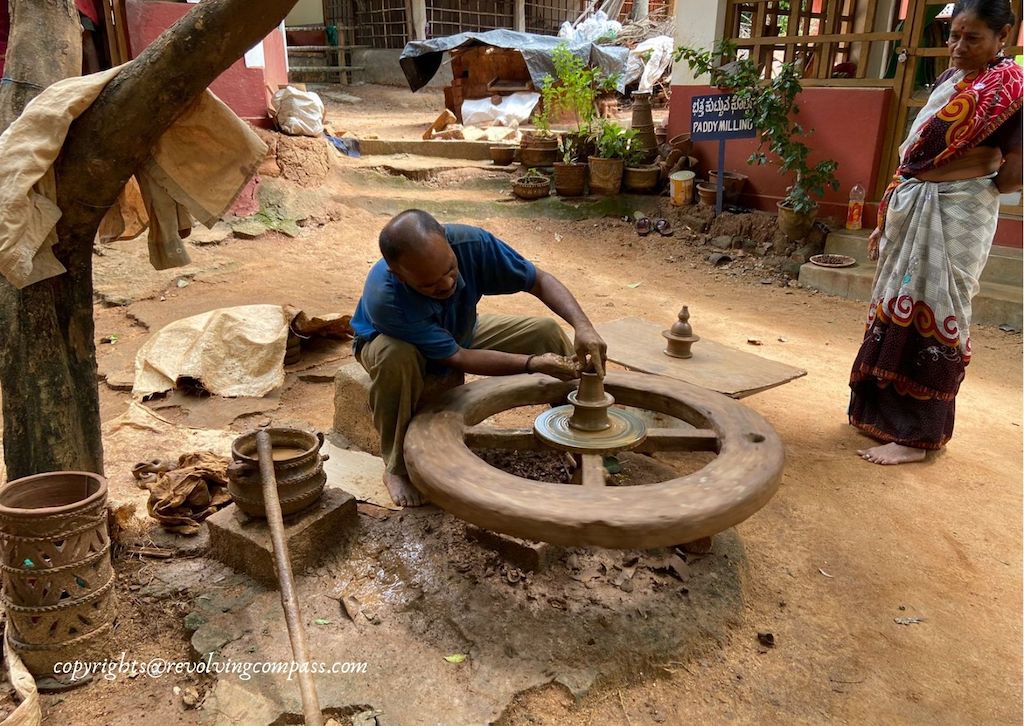
Finally, before you make a turn at the end, there is a beautiful depiction of a village panchayat as well.
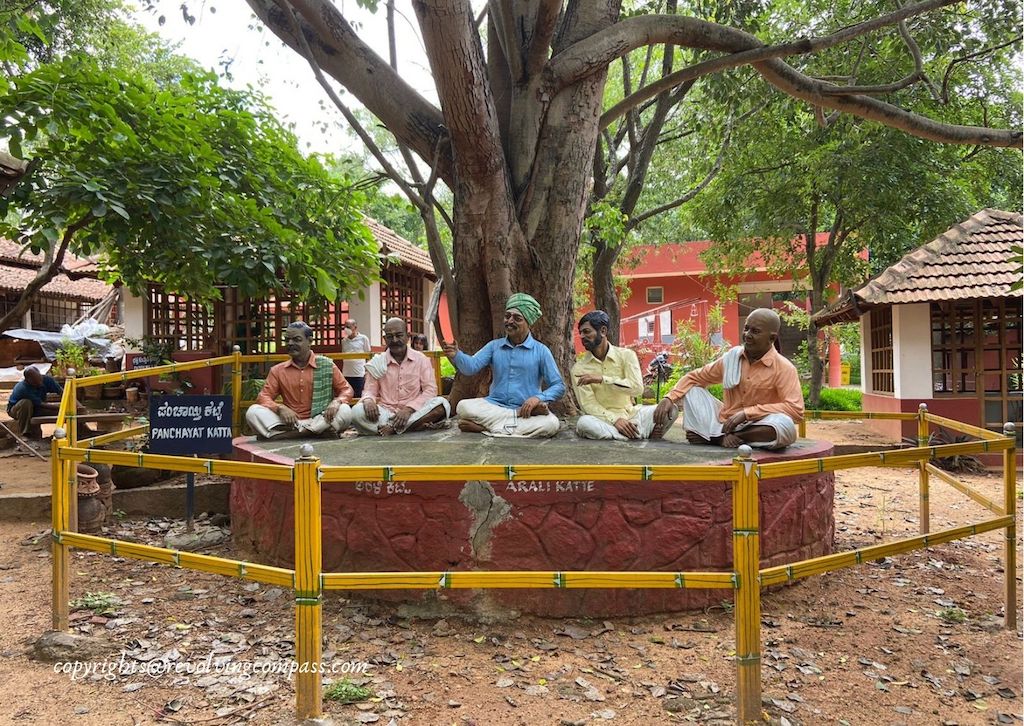
Shops at Janapada Loka Museum
With the pottery section, we completed almost one complete round around the Janapada Loka Museum. Here, there are few shops that have entry from inside the campus as well as from the main road. These shops are loaded with clay and wood items. Most prominently Channapatna Wooden Toys which are world famous. But beware, they also keep cheeper versions of the toys and Chinese stuff as well. So, if you are interested to buy authentic Channapatna toys, then do ask them. And they will show you the genuine products. We did buy a few things from here including some toys for kids etc. I will write about it in details in another post. Along with our experience visiting the Channapatna toys factory and exploring the heritage wooden toy trails in Channapatna. Which we did next as a part of this trip.
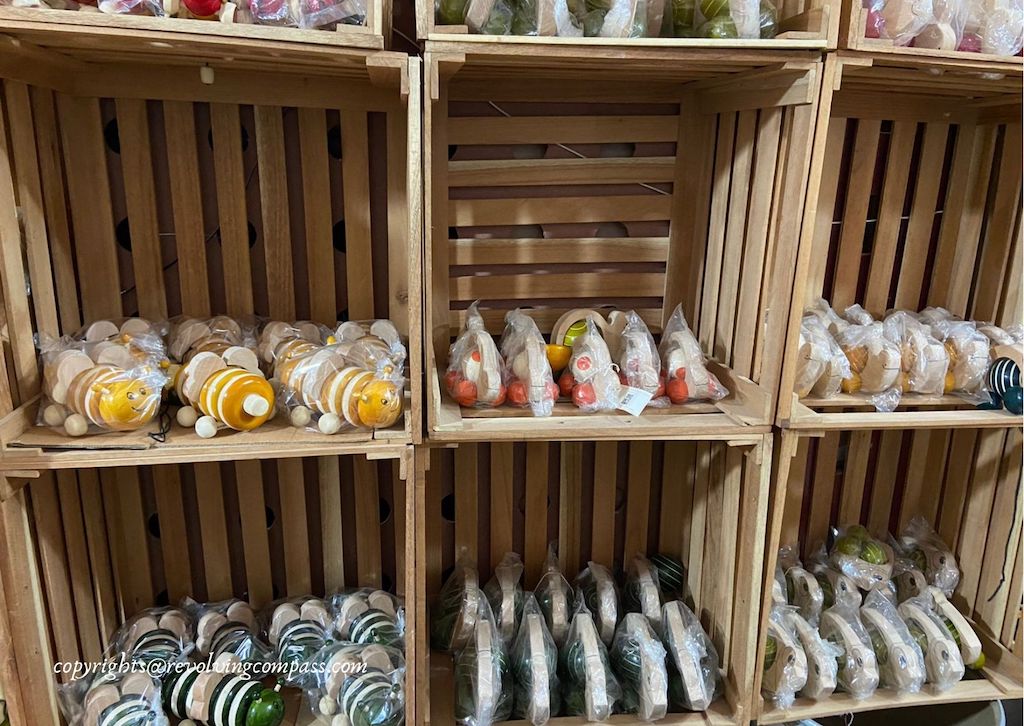
Other facilities at Janapada Loka Museum
One thing that you need not worry about at all while visiting the Janapada Loka Ramanagara Museum is refreshment. While you enter the museum, on the left side lies the big Kamath Restaurant. While on the right side lies a small refreshment shop that has some juices etc. You can also buy dry fruits, spices and few other things on this outlet. As you walk through the campus, there are more than one toilets also available. I spotted one near the amphitheatre and another one right before the shops, almost in the corner. To my respite, the restrooms were very clean.
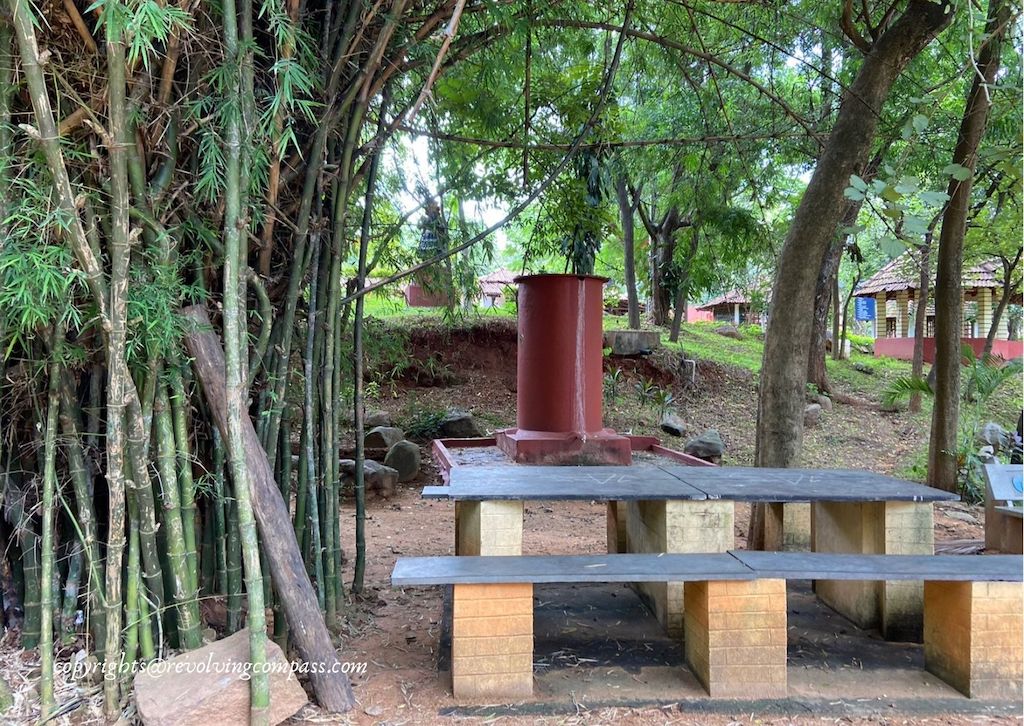
Then there is a drinking water facility also available in the open area at the center of the Museum. Also, there are several benches installed in this open area to help you rest after the tour 🙂
In fact there were couple of more small museums inside the campus which I skipped. As Ishi was feeling very sleepy by this time. Overall you should keep 2-3 hours time at hand to leisurely visit this campus. Although we are not versed in Kannada. Yet we didn’t have any problem understanding most of the depictions and artefacts in the museums. As our previous generation – our parent – who were with us on the trip could relate with most of them.
Places to visit near Janapada Loka Ramanagara
There are several other places to visit near Janapada Loka Ramanagara. Which you can plan for on a day trip from Bangalore. One of these that we covered on our own trip to Janapadaloka was Channapatna.
Channapatna toy factory and toy shopping
The town of Channapatna is located just 10km from from Janapada Loka. Channapatna is world famous for it’s wooden toys handmade and hand painted with organic colors. This heritage art is licensed to the households in Channapatna that have been making these authentic toys for generations. As a part of this trip to Channapatna, you can not just buy some of these toys. But also tour a toy factory at Channapatna and see for yourself how these toys are made. Like we did on our trip.
PS: Our writeup on our trip to Channapatna toy factory and what an experience it was.
Ramanagara
You can also explore the town of Ramanagara as a part of this trip. Ramanagara is particularly famous for it’s stone plateaus. And also as a place where the famous Bollywood movie “Sholey” was filmed. You can drive through the locations of the shooting. And also visit the Ramadevara Betta Vulture Sanctuary and some very beautiful old Shiva temples of Ramanagara. We also wanted to, but we were constrained by time. So, we are soon planning to do another trip covering the district of Ramanagara separately.
Domaine Sula Vineyard
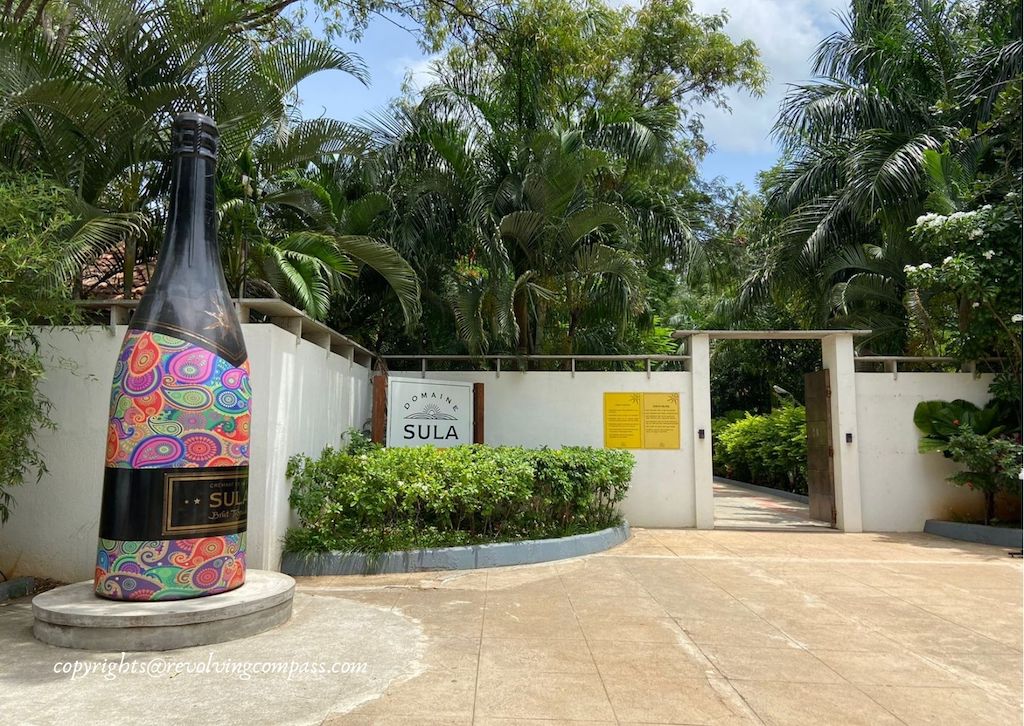
Almost 30km further to Channapatna lies Domaine Sula Vineyard. It is one of the many famous vineyards by the Sula group. Located 3 km inside from the main highway, it provides for a perfect spot for unwinding and a beautiful vineyard tour. We stopped here for lunch. Their restaurant has some delicious Italian cuisines as well as common Indian cuisines. But of course the main attraction is the numerous varieties of wines available here. The vineyard tour is done in batches of 15-18 people at regular interval of 1 hour. And it includes tasting of 4 types of wines as a part of the tour. If you are interested, do visit here. Grapes stamping is also arranged in the harvest season.
Of course covering all the above places in one day is simply not possible. So, we recommend an overnight stay in or around Ramanagara. Shilhaandra is one of the luxury resorts in Ramanagara that you can stay at. Then there are other options as well.
Tips on visiting the Janapada Loka Ramanagara Museum
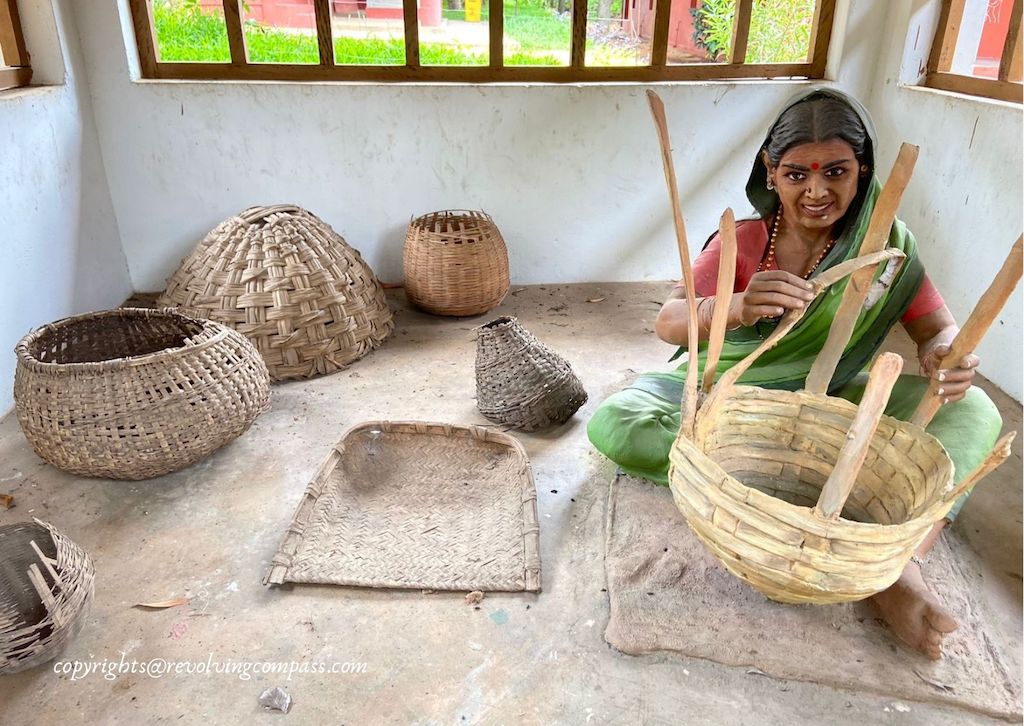
- Wear comfortable walking shoes as you will be walking and exploring, climbing up and down stairs and also some rough pathways.
- Most of the area is open air, so, it will be good to visit in the morning hours or after 3:30pm or so. But still peak summer days can get uncomfortable.
- Monsoon months of May – September will be good to visit. Choose a cloudy day. Luckily, it was not very sunny when we visited on 1st July. It was partially sunny, partially cloudy. So, we didn’t feel the heat. Since it was windy and the trees provide the much needed shelter and make the breeze cooler.
- Carry an umbrella which will come useful both in rainy and sunny days.
- You don’t really need to carry food and water as there are ample outlets and restaurants nearby.
- Park your vehicle outside, near the campus, or, outside the shops lining the campus wall.
- If you reach early in the morning, around 8:30 am or so, you can enjoy the buffet breakfast also.
- Don’t miss the cultural show if possible.
- There is also a library inside the Janapada Loka Museum with lots of books on the ancient culture, rural life and traditional handicrafts and toy making. Do check it out if you have time.
- Janapada Loka ticket cost INR 50/- per adult and INR 25/- per kid above 5 years.
PS: Some of our links are affiliated, this means we will earn a commission when you buy a service or product by clicking those links. However, this will have no extra cost for you.
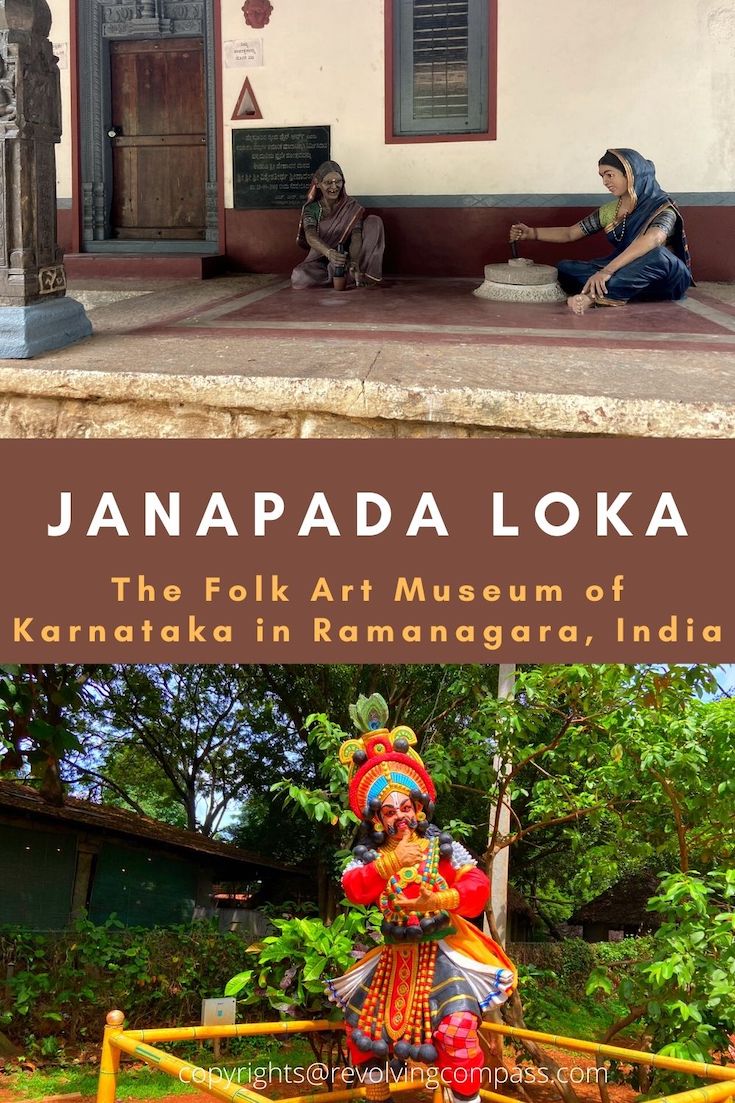 |
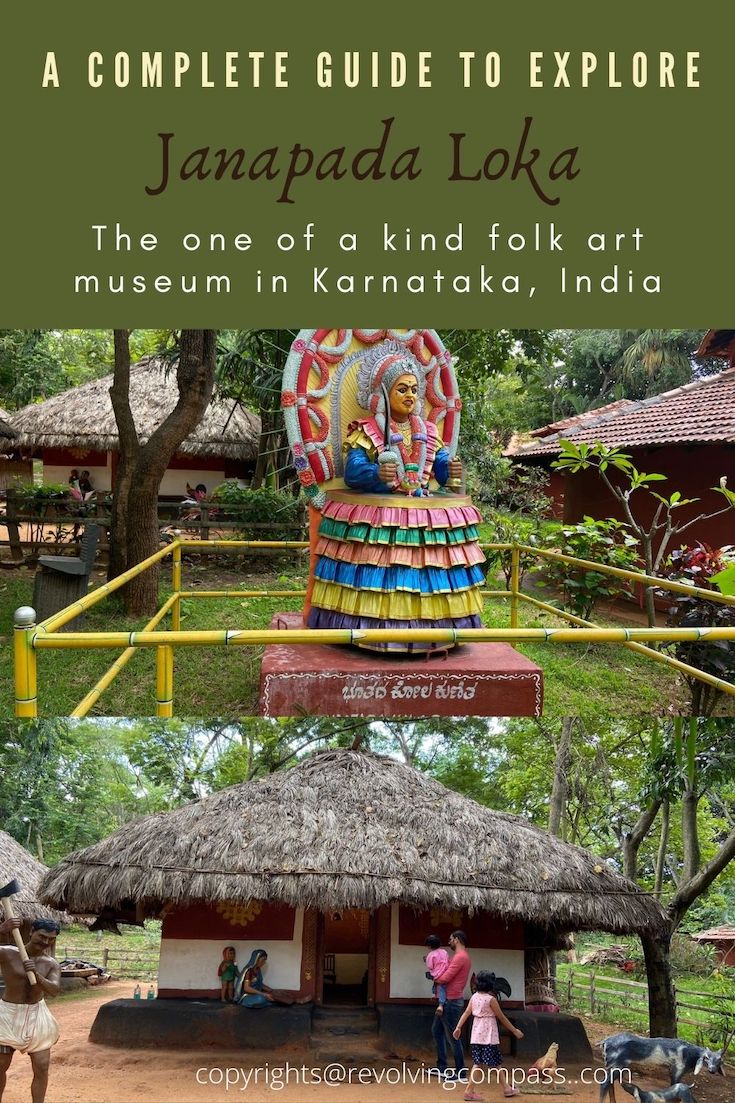 |
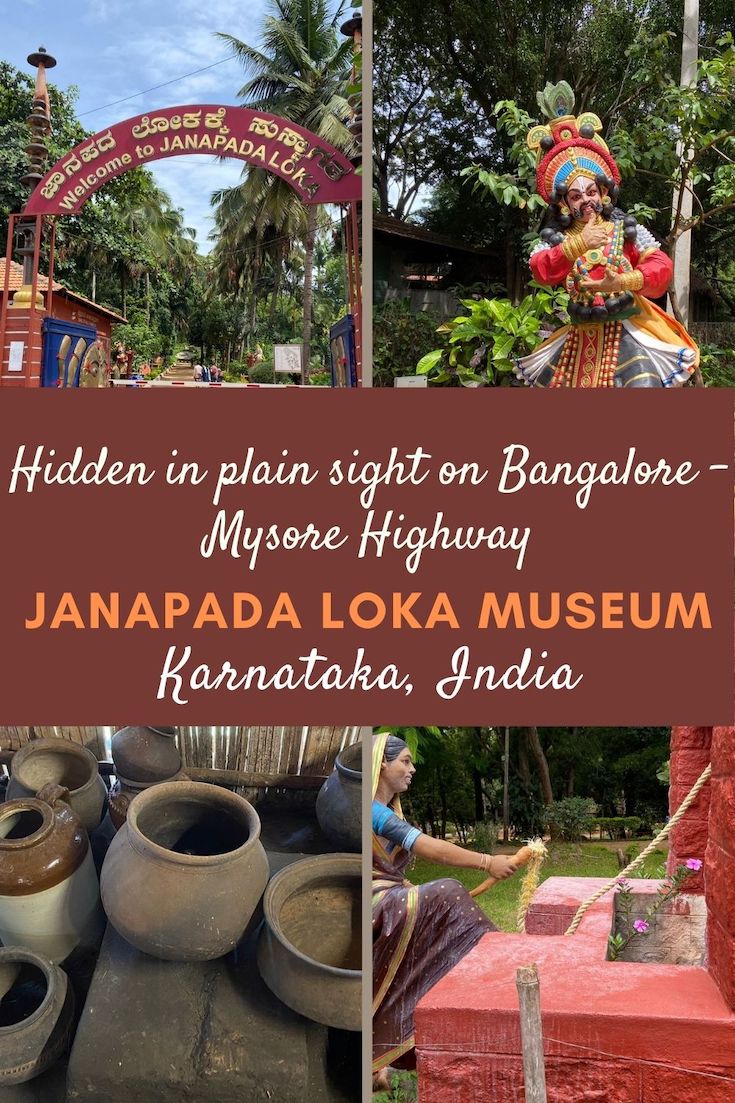 |
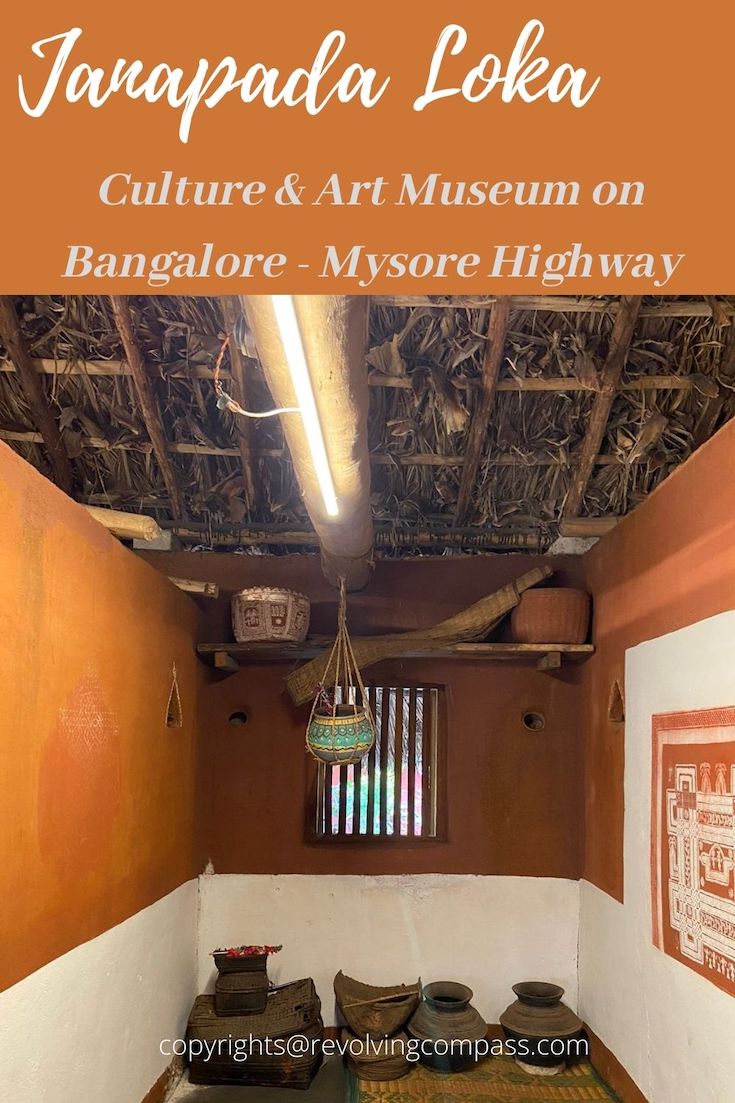 |
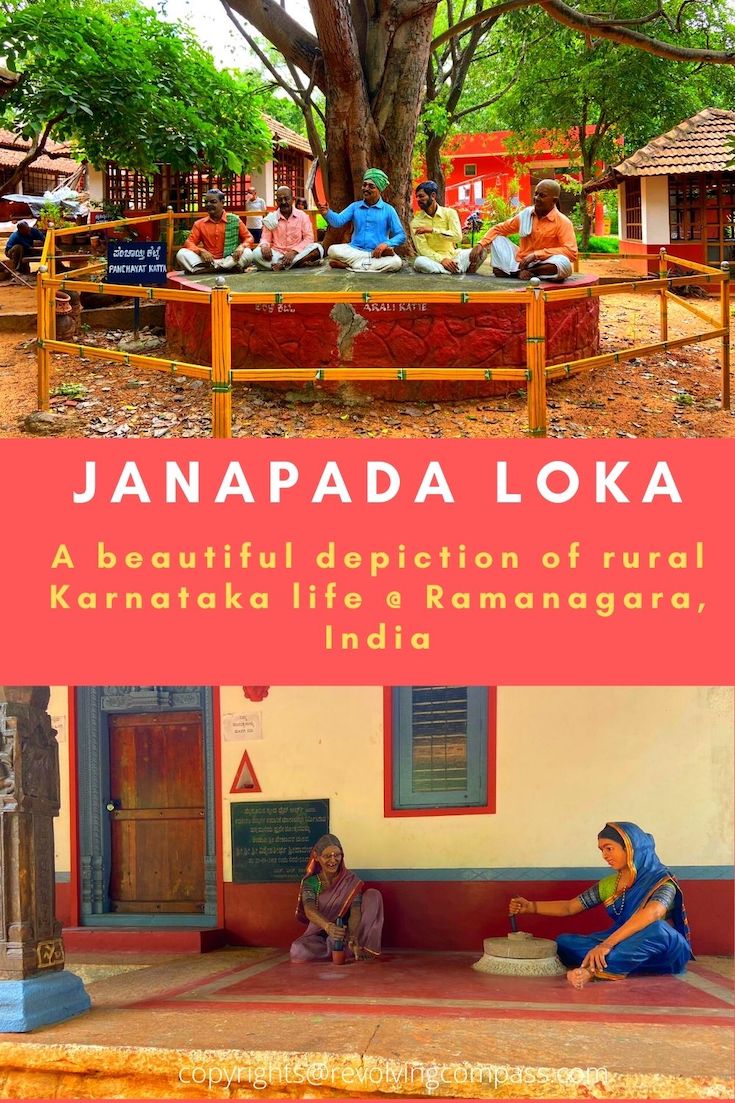 |
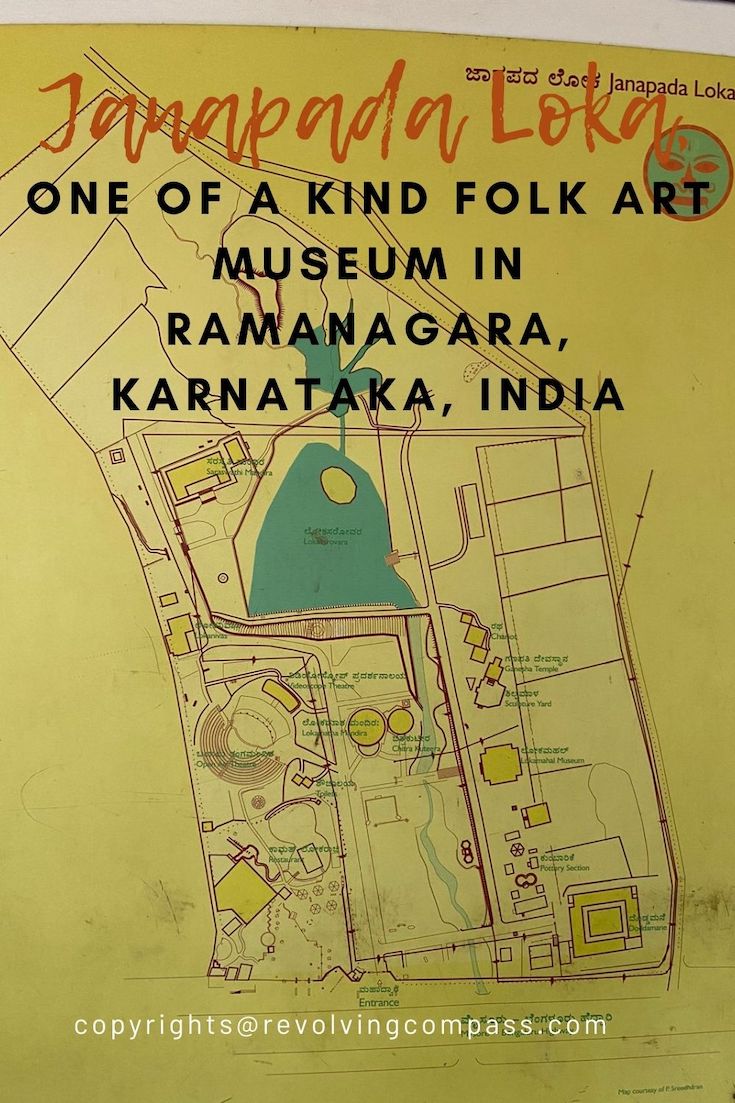 |
